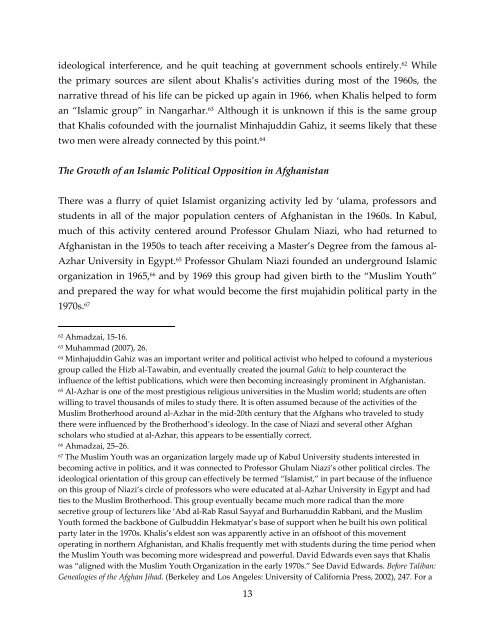Usama bin Ladin’s “Father Sheikh”:
Usama bin Ladin’s “Father Sheikh”:
Usama bin Ladin’s “Father Sheikh”:
You also want an ePaper? Increase the reach of your titles
YUMPU automatically turns print PDFs into web optimized ePapers that Google loves.
ideological interference, and he quit teaching at government schools entirely. 62 While<br />
the primary sources are silent about Khalis’s activities during most of the 1960s, the<br />
narrative thread of his life can be picked up again in 1966, when Khalis helped to form<br />
an “Islamic group” in Nangarhar. 63 Although it is unknown if this is the same group<br />
that Khalis cofounded with the journalist Minhajuddin Gahiz, it seems likely that these<br />
two men were already connected by this point. 64<br />
The Growth of an Islamic Political Opposition in Afghanistan<br />
There was a flurry of quiet Islamist organizing activity led by ‘ulama, professors and<br />
students in all of the major population centers of Afghanistan in the 1960s. In Kabul,<br />
much of this activity centered around Professor Ghulam Niazi, who had returned to<br />
Afghanistan in the 1950s to teach after receiving a Master’s Degree from the famous al‐<br />
Azhar University in Egypt. 65 Professor Ghulam Niazi founded an underground Islamic<br />
organization in 1965, 66 and by 1969 this group had given birth to the “Muslim Youth”<br />
and prepared the way for what would become the first mujahidin political party in the<br />
1970s. 67<br />
62 Ahmadzai, 15‐16.<br />
63 Muhammad (2007), 26.<br />
64 Minhajuddin Gahiz was an important writer and political activist who helped to cofound a mysterious<br />
group called the Hizb al‐Tawa<strong>bin</strong>, and eventually created the journal Gahiz to help counteract the<br />
influence of the leftist publications, which were then becoming increasingly prominent in Afghanistan.<br />
65 Al‐Azhar is one of the most prestigious religious universities in the Muslim world; students are often<br />
willing to travel thousands of miles to study there. It is often assumed because of the activities of the<br />
Muslim Brotherhood around al‐Azhar in the mid‐20th century that the Afghans who traveled to study<br />
there were influenced by the Brotherhood’s ideology. In the case of Niazi and several other Afghan<br />
scholars who studied at al‐Azhar, this appears to be essentially correct.<br />
66 Ahmadzai, 25–26.<br />
67 The Muslim Youth was an organization largely made up of Kabul University students interested in<br />
becoming active in politics, and it was connected to Professor Ghulam Niazi’s other political circles. The<br />
ideological orientation of this group can effectively be termed “Islamist,” in part because of the influence<br />
on this group of Niazi’s circle of professors who were educated at al‐Azhar University in Egypt and had<br />
ties to the Muslim Brotherhood. This group eventually became much more radical than the more<br />
secretive group of lecturers like ‘Abd al‐Rab Rasul Sayyaf and Burhanuddin Rabbani, and the Muslim<br />
Youth formed the backbone of Gulbuddin Hekmatyar’s base of support when he built his own political<br />
party later in the 1970s. Khalis’s eldest son was apparently active in an offshoot of this movement<br />
operating in northern Afghanistan, and Khalis frequently met with students during the time period when<br />
the Muslim Youth was becoming more widespread and powerful. David Edwards even says that Khalis<br />
was “aligned with the Muslim Youth Organization in the early 1970s.” See David Edwards. Before Taliban:<br />
Genealogies of the Afghan Jihad. (Berkeley and Los Angeles: University of California Press, 2002), 247. For a<br />
13


